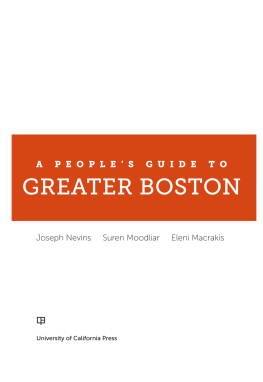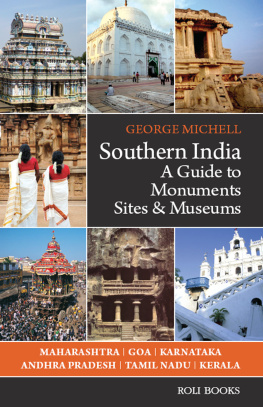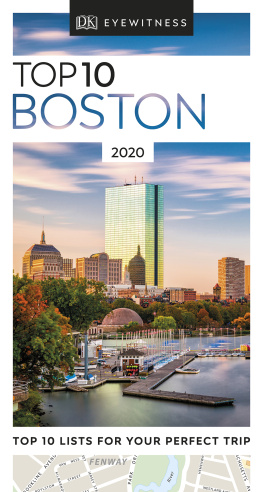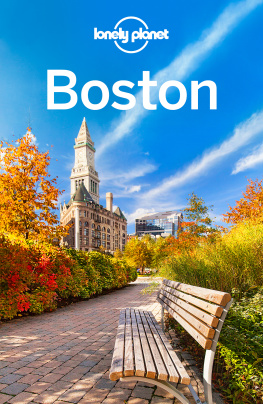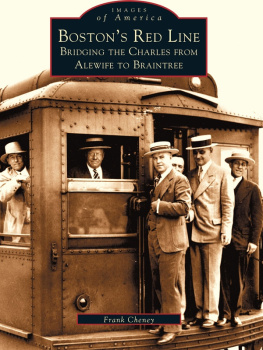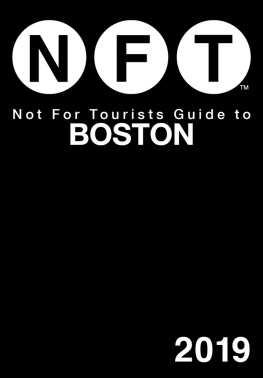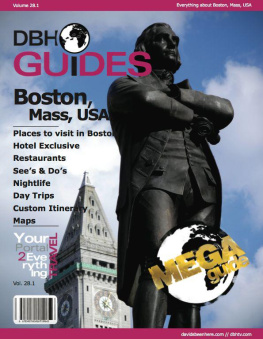Lyn Wilkerson - Historical Cities-Boston, Massachusetts
Here you can read online Lyn Wilkerson - Historical Cities-Boston, Massachusetts full text of the book (entire story) in english for free. Download pdf and epub, get meaning, cover and reviews about this ebook. year: 2010, publisher: Lyn Wilkerson, genre: Detective and thriller. Description of the work, (preface) as well as reviews are available. Best literature library LitArk.com created for fans of good reading and offers a wide selection of genres:
Romance novel
Science fiction
Adventure
Detective
Science
History
Home and family
Prose
Art
Politics
Computer
Non-fiction
Religion
Business
Children
Humor
Choose a favorite category and find really read worthwhile books. Enjoy immersion in the world of imagination, feel the emotions of the characters or learn something new for yourself, make an fascinating discovery.
- Book:Historical Cities-Boston, Massachusetts
- Author:
- Publisher:Lyn Wilkerson
- Genre:
- Year:2010
- Rating:3 / 5
- Favourites:Add to favourites
- Your mark:
- 60
- 1
- 2
- 3
- 4
- 5
Historical Cities-Boston, Massachusetts: summary, description and annotation
We offer to read an annotation, description, summary or preface (depends on what the author of the book "Historical Cities-Boston, Massachusetts" wrote himself). If you haven't found the necessary information about the book — write in the comments, we will try to find it.
Historical Cities-Boston, Massachusetts — read online for free the complete book (whole text) full work
Below is the text of the book, divided by pages. System saving the place of the last page read, allows you to conveniently read the book "Historical Cities-Boston, Massachusetts" online for free, without having to search again every time where you left off. Put a bookmark, and you can go to the page where you finished reading at any time.
Font size:
Interval:
Bookmark:
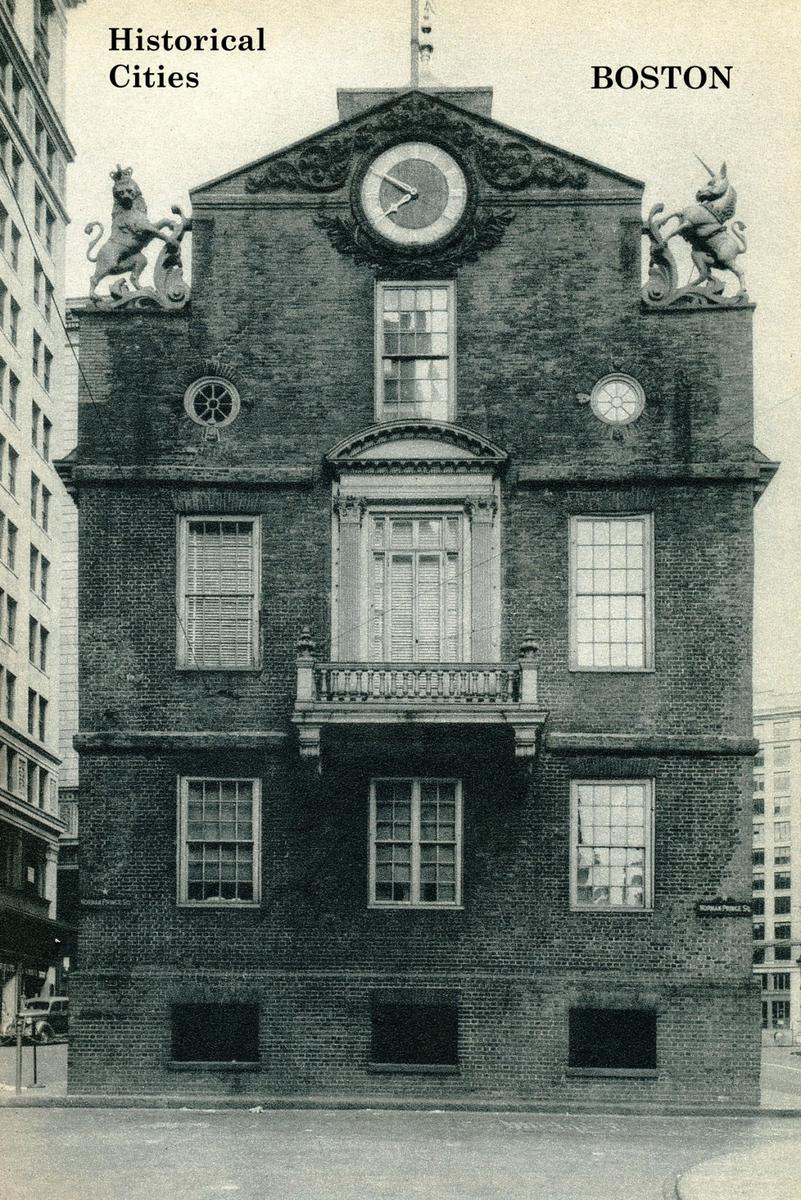
While every effort has beenmade to insure accuracy, neither the author nor the publisherassume legal responsibility for any consequences arising from theuse of this book or the information it contains.
All maps are by theauthor.
Historical Cities-Boston,Massachusetts
SmashwordsEdition
Lyn Wilkerson
ISBN978-1-4524-7161-7
All Rights Reserved.Copyright 2010 Lyn Wilkerson
No part of this book may bereproduced or transmitted in any form or by
any means, graphic,electronic, or mechanical, including photocopying,
recording, taping or by anyinformation storage or retrieval system,
without the permission inwriting from the author.
LicenseNotes :
This ebook is licensed foryour personal enjoyment only. This ebook may not be re-sold orgiven away to other people. If you would like to share this bookwith another person, please purchase an additional copy for eachperson. If youre reading this book and did not purchase it, or itwas not purchased for your use only, then please purchase your owncopy. Thank you for respecting the hard work of thisauthor.
Introduction
This guide, along with the variousothers produced by Lyn Wilkerson and Caddo Publications USA, arebased on the American Guide Series. Until the mid-1950s, the U.S.Highway System provided the means for various modes of transport toexplore this diverse land. To encourage such explorations, theWorks Projects Administration under President Franklin D. Rooseveltand the Federal Writers Project created the American Guide Series.This series of books were commissioned by the Federal Government tocapture the culture and history of the United States and providethe direction necessary for travelers to explore it. Each statecreated a commission of writers who canvassed their respectiveterritories for content to submit. The preliminary works were thensent to Washington D.C. for final assembly in to a standard format.The result was a travel guide for each state. The series spread toinclude guides for important cities as well. After the State Guideswere complete, the concept of a national guide was developed.However, it would not be until 1949, with the backing of HastingsHouse Publishing, that a true national guide would be created.Through several rounds of condensing, the final product maintainedmuch of the most essential points of interest and the most colorfulmaterial.
To quote from the Californiaedition of the American Guide Series, romance has been kept in itsplace... The intent of this guide is to provide informationabout the historic sites and landmarks within a given city. It isnot our desire to dramatize the history or expand on it in any way.We believe that the character and culture of this state, and ourcountry as a whole, can speak for itself. The guide has beencreated, not for just travelers new to the city, but for currentresidents who may not realize what lies just around the corner intheir own neighborhood. The goal of Caddo Publications USA is toencourage the exploration of the rich history that many of us driveby on a regular basis without any sense it existed, and toentertain and educate so that history will not be lost in thefuture.
* * * * * * * *
This guide containshistorical sites and landmarks for the city of Boston, as well asthe adjacent Cambridge and Charlestown areas. It is not intended tobe all inclusive, although future editions will follow withadditional listings. In all, close to 90 sites are listed withinthis guide, along with detailed maps to assist in locating them. Atthe back of the guide is a table of GPS coordinates for the sitesprovided.
Table of Contents:
Although Norsemen, theFrench explorer Champlain, and the Dutch all are said to havevisited Boston harbor, and Captain John Smith left us a map of it,no actual settlement was made until the 1620s. Bostons firstsettler was William Blackstone, a recluse of scholarly and probablymisanthropic mental cast, formerly a clergyman of the Church ofEngland. He had built himself a hut on the western slope of what isnow Beacon Hill, planting his orchard on what later became BostonCommon. At that time, the wilderness occupied the peninsula, whichwas about one-third the size of todays Boston peninsula. Almost anisland, it jutted out into the bay, joined to the mainland by along, narrow neck like the handle of a ladle. It was a mile wide atits widest, three miles long, and the neck was so narrow and so lowthat at times it was submerged by the ocean. Blackstones realm wasbounded on the west by a mud flat (the Back Bay); on the north by adeep cove (later dammed off to make a mill pond); on the east by asmall river which cut off the North End and made an island of it,and by a deep cove (later known as the Town Cove); and on thesouth by another deep cove. Here, the disillusioned clergyman readhis books, farmed a little, traded a bit with the Indians, andbreathed air uncontaminated by any other white man.
His idyllic solitude wasrudely shattered after four or five years, however, by the arrivalof John Winthrop with a company of some eight hundred persons whosettled in what is now Charlestown. Their miseries were many. Thewater at Charlestown was brackish, and their settlement could noteasily be defended against Indian raids. Blackstone visited themand was melted by the spectacle of their plight. He invited them tocome across to his peninsula and the company eagerly accepted hishospitality. This occurred in 1630, the year of the birth ofBoston.
Winthrops settlers calledit Trimountain, possibly because of three hills later known asBeacon Hill, Copps Hill, and Fort Hill. The first yearfamiliarized the Englishmen and their families with the rigors ofthe New England climate. It was too late to plant crops and morethan two hundred died of starvation and exposure. The followingspring, a ship laden with provisions, long overdue, dropped anchorin the bay, and a famine was averted. Fisheries were established,and fir and lumber created an export market. Within four years,more than four thousand Englishmen had emigrated to Boston and itsvicinity. Twenty villages developed out of the peninsula town toform a Puritan Commonwealth.
The settlement soon becamethe capital of the Massachusetts Bay Colony, governed by atheocracy which rigidly dictated to citizens in matters ofreligious dogma and private conduct. Dissenters were persecuted.Roger Williams and his Quaker followers were driven out, as wereAnabaptists and Antinomians (latter led by indomitable AnneHutchinson. When Quakers returned, they were severely punished. In1659 and 1660, three men and one woman were executed on BostonCommon for thus offending. Nevertheless, culture and education werevalued by Puritans. In 1635, General Court established the firstfree school in Boston. About the same time, Harvard University wascreated in nearby Cambridge.
Never much of a farmingcommunity, the city prospered greatly as a port and trading center.In 1631, a Boston-built vessel, the tiny Blessing of the Bay , was launched,and from then on shipbuilding continued as an important industryuntil the American Civil War era. After the Stuart restoration inEngland in 1660, Boston, which had actively sympathized with theregime of Oliver Cromwell, became the scene of monarchicalreprisals. In 1684, the Court of Chancery, sitting in the TownHall, voided the original colonial charter. Governor Andros, sentby King James II, established a virtual dictatorship. He attemptedto break down the religious and political monopoly of the Puritansby widening the franchise and establishing the right of freeworship.
Boston put on acurtain-raiser to witchcraft hysteria in 1688, but suffered theravages of the persecution less than neighboring towns. That waslargely because, when an epidemic broke out in full force in 1692,sinister accusations were leveled at the wife of Governor Phipps.Phipps, naturally enough, thereupon bore down on witch baiters. Bythis time, Bostons population had grown to 7,000. The citys tradeboomed mightily with the development of the Rum-Slave-Molassestraffic triangle. By 1666, 300 ships, mostly Boston-owned, piledout of port. In 1691, a royal governor was sent. In 1733, theMolasses Act was passed, but the Colonial merchants had virtuallyfree trade until 1764. That year, Grenville began the vigorousenforcement of the mercantilist measures. From then on, frictionincreased rapidly and the Colonies developed a burning sense ofgrievance.
Next pageFont size:
Interval:
Bookmark:
Similar books «Historical Cities-Boston, Massachusetts»
Look at similar books to Historical Cities-Boston, Massachusetts. We have selected literature similar in name and meaning in the hope of providing readers with more options to find new, interesting, not yet read works.
Discussion, reviews of the book Historical Cities-Boston, Massachusetts and just readers' own opinions. Leave your comments, write what you think about the work, its meaning or the main characters. Specify what exactly you liked and what you didn't like, and why you think so.



